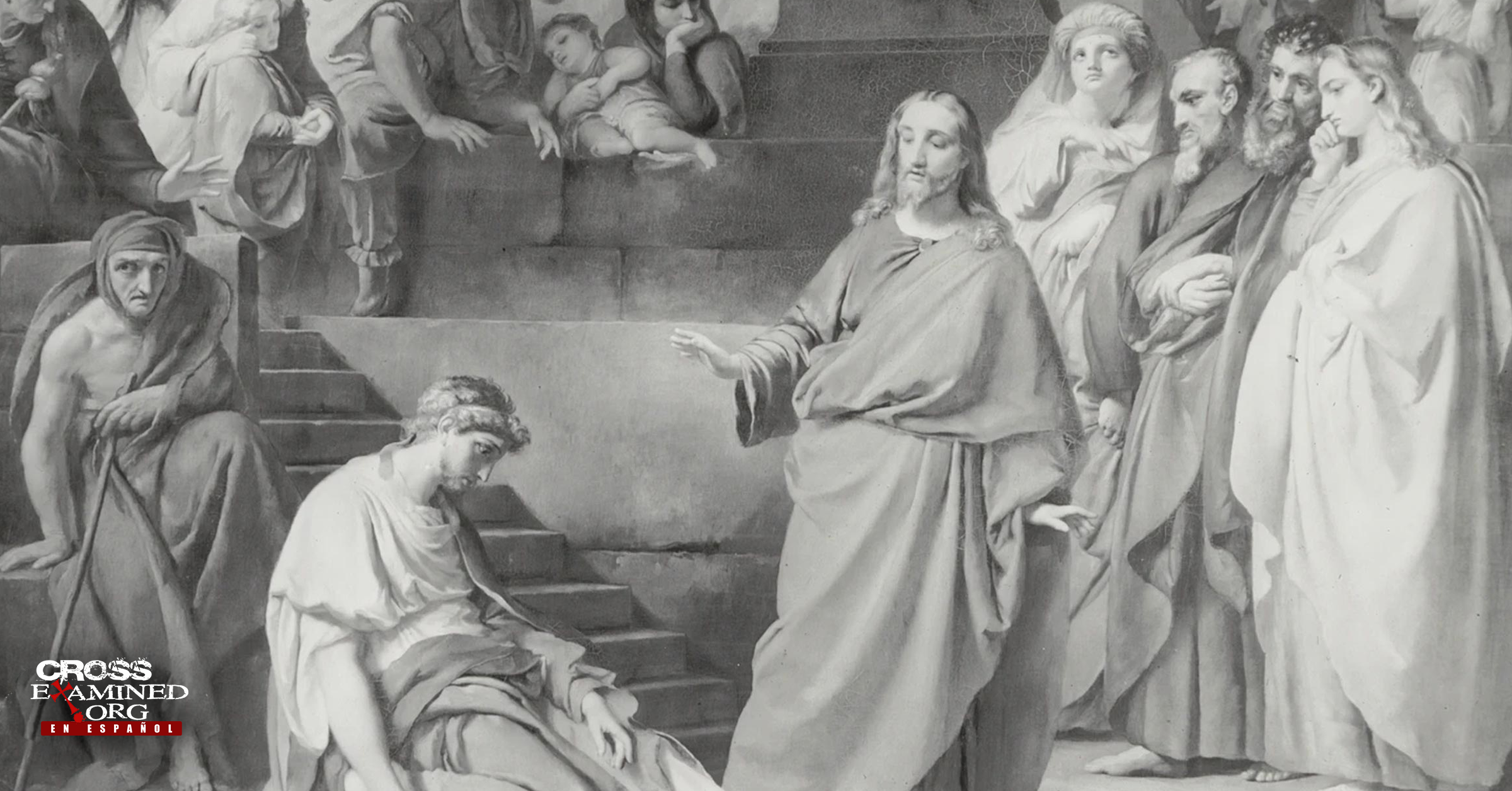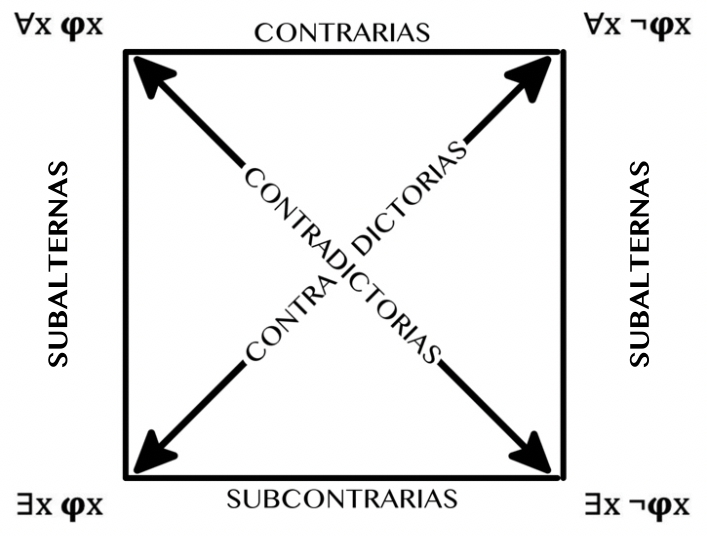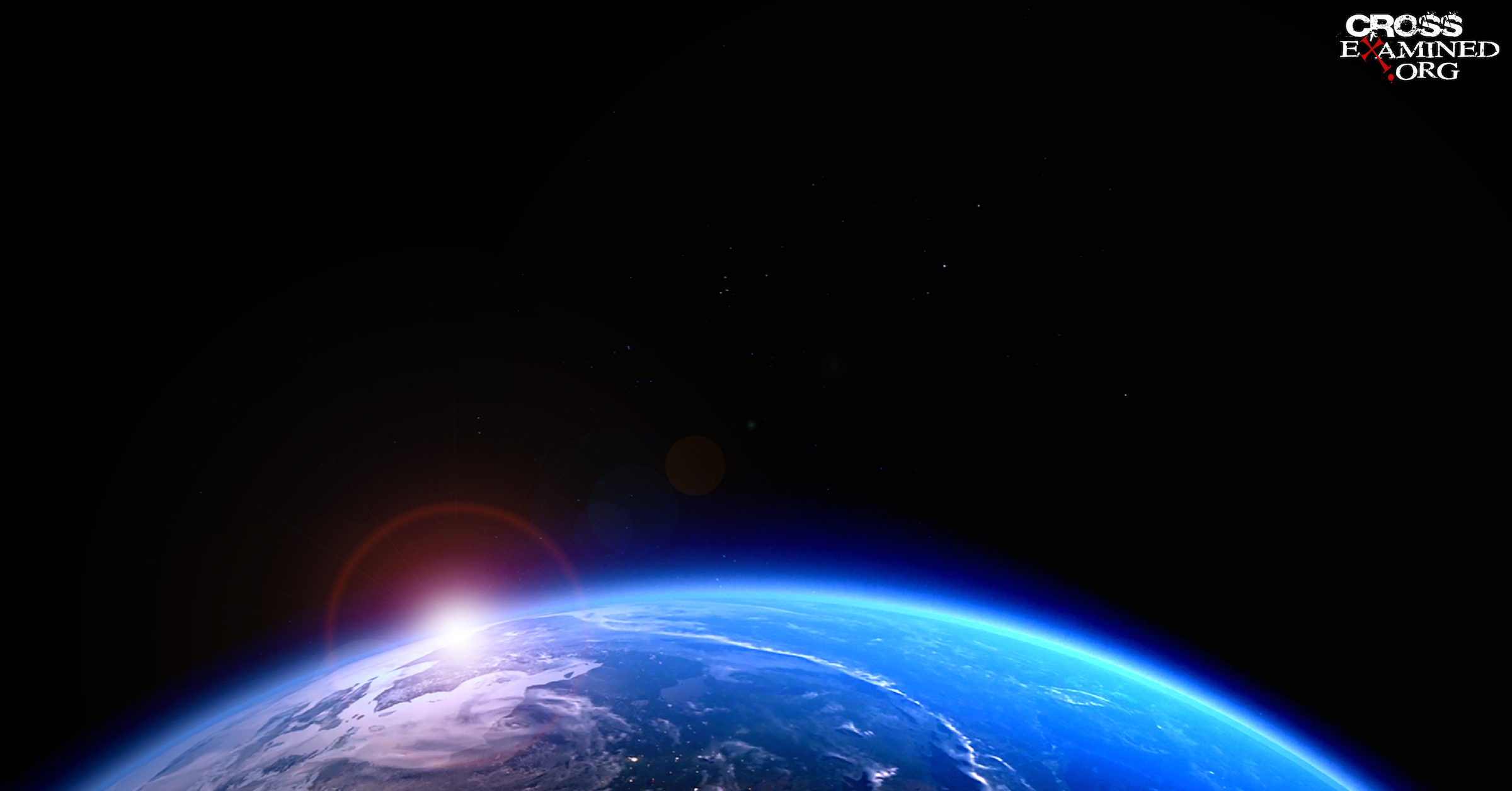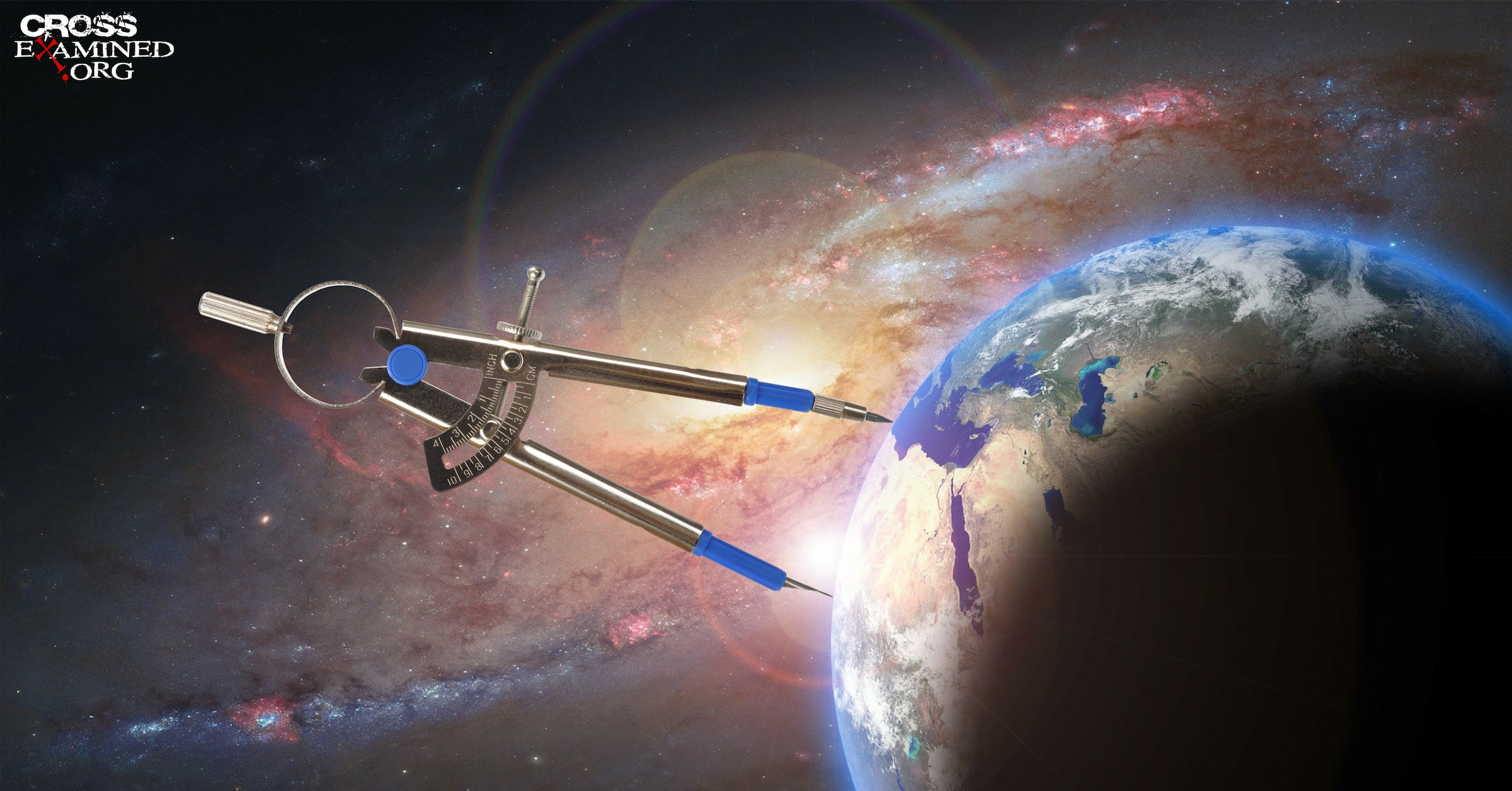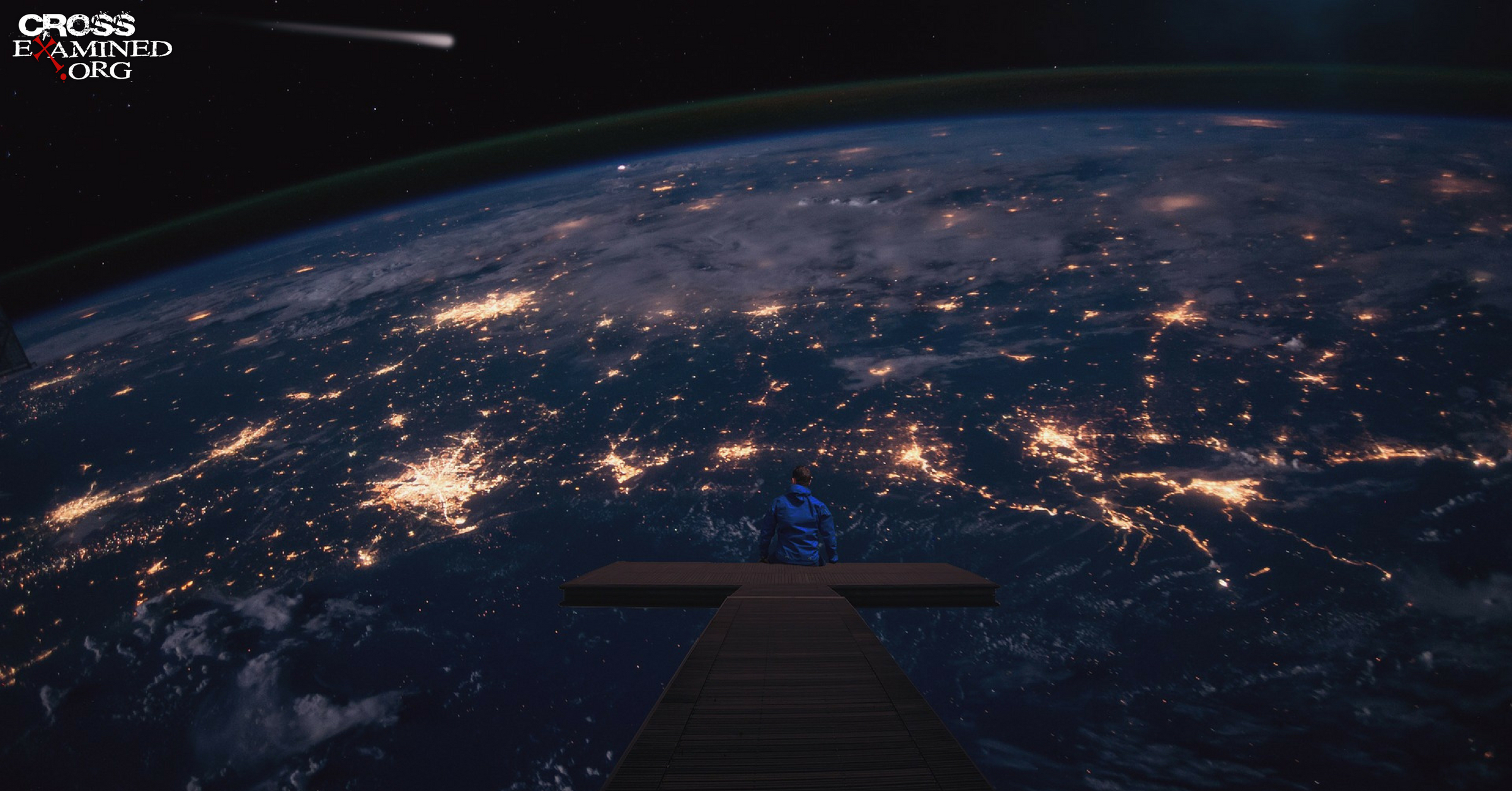PRELIMINARY REMARKS
Writing an article on the fine-tuning of the universe that is too short and simple runs the risk of being the target of doubts and objections, and a lengthy and technical exposition runs the risk of being difficult for the reader to understand or even boring due to the complexity of the content. That is why I am grateful to Professor Robin Collins for not only allowing me to translate much of his work, but also for providing me with the slides that he uses in his lectures on the fine-tuning of the universe, which is the visual material that I will use in this article.
WHAT IS FINE TUNING?
Before we make an argument about fine-tuning, the first thing to do is to know what fine-tuning is and whether there is such a thing for the universe. Well, by fine-tuning we mean the fact that the universe is extremely fine-tuned for the existence of what Professor Collins calls “embodied conscious agents,” which require stable and reproducible complexity. An analogy for the universe would be a biosphere. The biosphere has to be perfectly structured and fine-tuned to be self-sustaining (the right environment, energy consumption, etc.) so that human beings can exist in it. The universe is like that, that is how it must be structured in an extraordinary way.
Three kinds of Fine Tuning for life
The evidence for fine-tuning of the universe is of three kinds:
- The fine-tuning of the laws of nature.
- Fine-tuning of physical constants.
- The fine-tuning of the initial mass-energy distribution of the universe at the time of the Big Bang.
The Fine Tuning of the Laws of Nature
When we talk about the fine-tuning of the laws of nature we mean that the universe must have precisely the right set of laws in order for highly complex life to exist.
Examples:
- Existence of Gravity.
- Existence of the Electromagnetic Force.
- Existence of the Strong Nuclear Force.
- Existence of the Quantification Principle.
- Existence of the Pauli Exclusion Principle.
Let’s take the existence of gravity, without it you have no stars, you have no planets, and therefore you have no life! Or without the Electromagnetic Force you would have no atoms, so you would not get life either, then you have no chemical bond, and of course, you have no life either.
We can mention other examples, but this is enough to understand that the appropriate laws are necessary for life of great complexity to exist. If any of these laws were missing, such a type of life would be impossible.
Fine-tuning of physical constants
By physical constants, we mean the fundamental numbers that occur in the laws of physics, many of which must be fine-tuned to an extraordinary degree for life to occur.
For example, take the Gravitational Constant—designated by G—which determines the strength of gravity through Newton’s Law of Gravity:

Where F is the force between two masses, m 1 and m 2 , that are a distance r apart. If you increase or decrease G then the force of gravity will correspondingly increase or decrease. (The actual value of G is 6.67 x 10 -11 Nm 2 / kg 2 .)
Now, to get an idea of how finely tuned the force of gravity indicated by G is we must first look at the range of fundamental forces in nature:
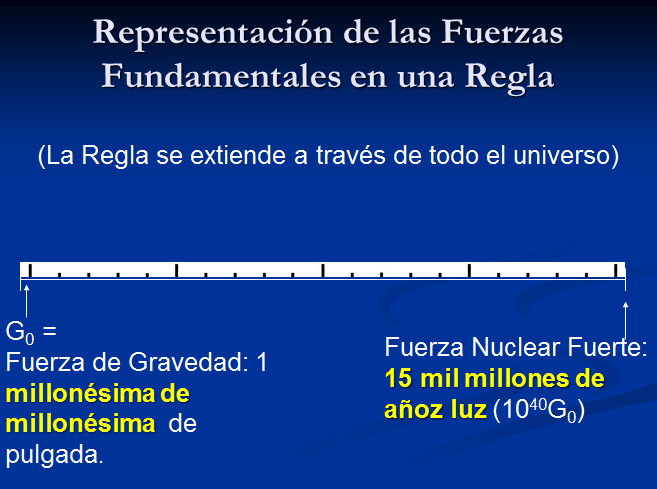
Note that the Strong Nuclear Force is 10,000 sextillion [1] times the Force of Gravity. Too complicated? Well, let’s make this more digestible. Imagine you have a ruler big enough to stretch across the entire universe, now we’ll place the points where the Force of Gravity and the Strong Nuclear Force would be located. We’d get something like this:
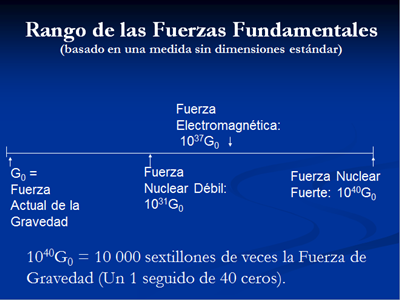
Now, Professor Collins calculates that if you increase the Force of Gravity by one part in 1034 of the range of the fundamental forces (i.e. a billion-fold increase in strength), then even single-celled organisms would be crushed, and only planets smaller than about 31 metres in diameter could support life with our brain size. Such planets, of course, would not be able to support an ecosystem to sustain life for our level of intelligence.
We could continue giving examples of what would happen if you kept playing with the value of the Gravity Force, but I think this one is more than enough to understand what we are talking about.
So we can see that for life to occur, the Force of Gravity must fall within a very, very narrow range of values compared to the total range of the fundamental forces.
Let’s look at one more analogy. Imagine a radio dial large enough to span the entire universe. The station WKLF (K-Life) allows life. So:
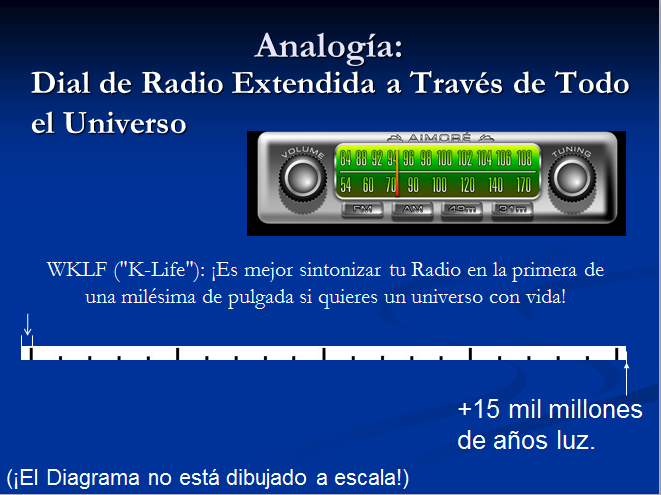
Only by tuning into the right frequency (the first thousandth of an inch) of all those on the radio dial (more than 15 billion light years away) can you get a universe with life.
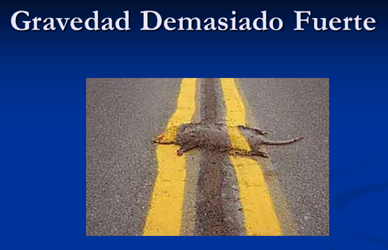 And so the same thing would happen if you were to play around with the values of the other constants, if they had slightly different values then complex material systems would not arise, so if you want life to exist then the constants of physics must fall within a very narrow range of values. This is widely acknowledged, the famous cosmologist, Stephen Hawking, says:
And so the same thing would happen if you were to play around with the values of the other constants, if they had slightly different values then complex material systems would not arise, so if you want life to exist then the constants of physics must fall within a very narrow range of values. This is widely acknowledged, the famous cosmologist, Stephen Hawking, says:
The remarkable fact is that the values of these numbers [i.e. the constants of physics] seem to have been very finely tuned to make the development of life possible. [2]
Former director of Cambridge University Observatories, Dr Dennis Sciama, also states:
If you change the laws of nature a little bit, or you change the constants of nature a little bit… it is very likely that intelligent life would not have been able to develop. [3]
Fine-tuning the Initial Mass-Energy Distribution
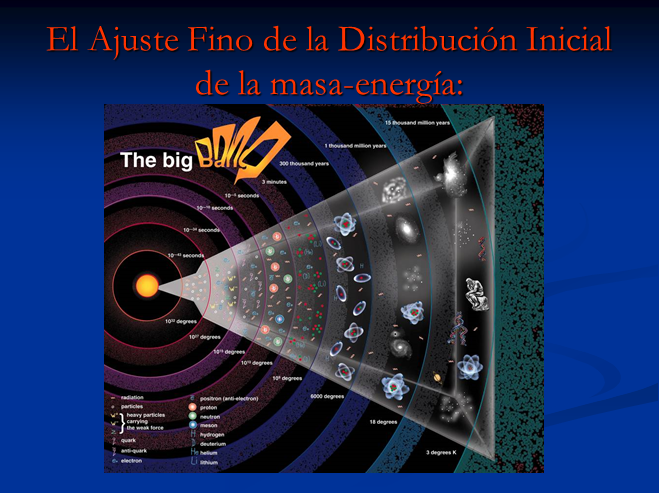
What does the fine-tuning of the initial mass-energy distribution mean? Well, according to standard cosmology, the universe started with the Big Bang, about 13.7 billion years ago. All the matter was condensed into a region smaller than the size of a golf ball, then it exploded and expanded. And in order for that matter to get galaxies, and to get life, it had to have a very precise arrangement. Professor Collins gives us an analogy of this: If you look at a zygote with a powerful microscope, you would see that it is intricately structured. It wouldn’t look that way from the outside, you would just see it as a blob of protoplasm, but under the microscope, you would have an intricate structure of DNA and all the other kinds of organelles in cells to make up a human being. So, in the same way, the universe has to be in an extremely precise state, and those are the initial conditions, the fine-tuning of mass-energy to get galaxies, stars, and ultimately to get like us.
Now comes the important question, how precise must the initial mass-energy distribution be for life to exist? Well, Roger Penrose, one of the UK’s leading theoretical physicists and cosmologists answers this question in his book The Emperor’s New Mind :
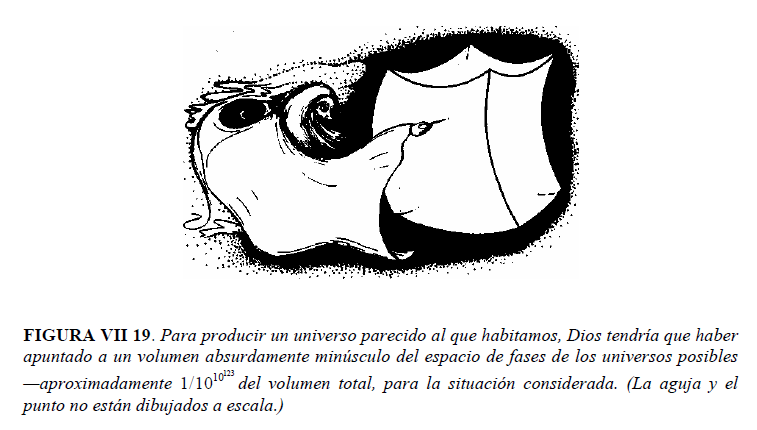
(Phase space is a space of possibilities, with a standard probability measure that tells us how likely it is to be in that part of that possibility space.)
A figure so incredibly large that Penrose says:
We couldn’t even write the whole number in ordinary decimal notation: it would be a “1” followed by 10 123 “0”s. Even if we wrote a “0” for every proton and every neutron in the entire Universe—and added all the other particles as well—we would still be way short [4] .
Here is an analogy for the formidable precision of the Big Bang explosion according to Penrose’s calculations, which must be much greater than that needed to blow up a pile of rubble into a fully formed building filled with desks, tables, chairs and computers!

So we can conclude that the initial mass-energy distribution must fall within an excessively narrow range for complex life to occur.
Summary
We have seen that for complex life to exist in the universe, it has to be well structured as a biosphere, and that we have not just one piece of evidence for this, but many pieces of evidence that point to such fine-tuning, and these are the cases of the fine-tuning of the laws of physics, of the physical constants and of the initial distribution of mass and energy.
FORMULATING THE UNIVERSE FINE-TUNING ARGUMENT FOR THE EXISTENCE OF GOD
There are different ways to formulate an argument from fine-tuning, in this post I will focus only on the versions of William Lane Craig, Robin Collins, and Peter S. Williams.
William Lane Craig’s Fine-Tuning Argument
What is the reason for this fine-tuning? Well, there are three options that have been offered as the best explanation and with which we can formulate our first premise of the argument:
- The fine-tuning of the universe is due either to physical necessity, chance, or design.
Physical need
Let’s first consider the physical necessity alternative. This alternative tells us that the universe must be one that permits life – in other words, that the values and constants cannot be any other way. In this alternative, the existence of a universe that prohibits life is impossible . Of course, that is a mistake, since such a universe is not only possible , but much more probable than a universe that permits life! And the reason for this is because the constants and quantities are not determined by the laws of nature – they cannot be predicted on the basis of current physical theory. There is no reason or evidence to suggest that fine-tuning is necessary.
One could appeal to string theory, but this does not settle the matter at all. Stephen Hawking says:
Even if we understand the ultimate theory, it is not going to tell us much about how the universe began. It cannot predict the dimensions of spacetime, the symmetry group or Gauge group, or other parameters of the effective low-energy theory… It is not going to determine how this energy is partitioned between conventional matter, and a cosmological constant, or quintessence… So to return to the question… Does string theory predict the state of the universe? The answer is that it does not. It allows for a vast landscape of possible universes, in which we occupy an anthropically allowed location [5] .
And that vast landscape of possible universes that string theory allows for is about 100,500 different universes, all of them governed by the present laws of nature, so it does nothing to deliver the observed values of the constants and physical quantities in a necessary way.
Chance/brute fact hypothesis
Now let’s move on to our second alternative: Chance or brute fact.
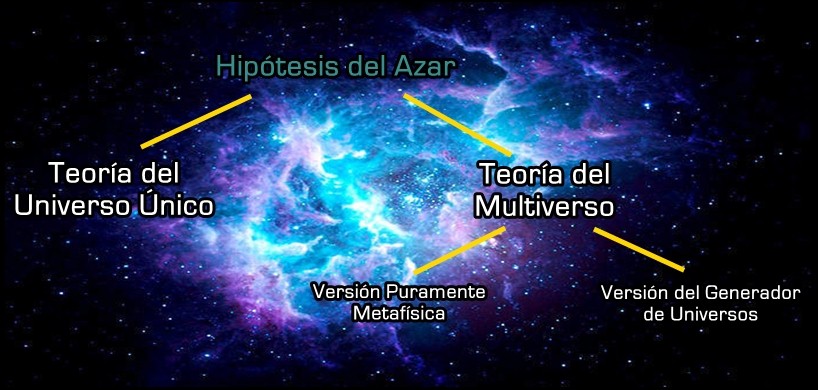
One Universe Theory
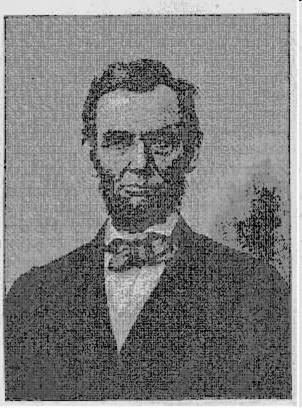
This hypothesis comes in two forms, the first is with respect to the one universe theory, i.e. our universe is the only one in existence. Those who hold this alternative tell us that the fact that a life-supporting universe exists is just a chance occurrence that has and requires no explanation. In simpler words, our existence is just an “extraordinarily lucky accident.” Of course, this hypothesis is not accepted among most people because of its improbability. As Robin Collins exemplifies, it would be as improbable as believing that a painting of Abraham Lincoln’s face is the result of an extraordinarily lucky ink spill, because it is not only extraordinarily improbable, but it is highly significant, these two characteristics go together.
Professor Peter S. Williams puts it this way, we do not infer intelligent design just from high improbability, but from the combination of a “highly improbable” event with a “very special” pattern. He says:
A long string of random letters is complex (unlikely) but unspecified (does not fit any independently determined pattern). A short string of letters might be specified – such as the word “so” – but it would not be sufficiently complex to overcome chance’s ability to explain the event. Neither complexity without specificity nor specificity without complexity requires us to infer design. However, if you saw a Shakespeare play written on a Scrabble board, you would infer design. A play is both specific and sufficiently complex to merit an inference of design on the grounds that “in all cases where we know the causal origin of… specific complexity, experience has shown that intelligent design plays a causal role” [6] . So too with cosmic fine-tuning [7] .
Professor Williams gives us another analogy: Imagine you see someone enter a sequence of numbers into an ATM and then get their money back. What would you infer from this situation? Was the subject lucky or did they get their money by design? It is when a complex, contingent event matches a specific, independent pattern that we infer design.
Multiverse Theory
But maybe if you spilled ink enough times you would get Lincoln’s face, or if you put too many monkeys with too many typewriters, one of them might write a paragraph of Shakespeare’s play. This is what is known as the so-called “multiverse hypothesis,” according to which there are a huge number of universes with not only different initial conditions, but also with different values of the constants of physics, and even laws of nature. Therefore, simply by chance, some universe will have the “winning combination” for life and thus have an explanation for why a universe exists that allows life. The most common analogy proposed by the proponents of this hypothesis is that of the lottery, in the same way that you can draw many tickets with different combinations of numbers, only one of them has the “winning combination” and the person who gets that ticket will simply be the winner by luck, a mere matter of probability. This hypothesis is widely accepted and has quite prominent proponents, such as Professor Max Tegmark, of the Massachusetts Institute of Technology Cosmologist, Sir Martin Rees, Astronomer to the Royal Family of Great Britain, Stephen Hawking, among many others.
Purely Metaphysical Version
The multiverse theory has two versions, the first of which is the Purely Metaphysical version , which tells us that all possible universes exist, all possible realities exist, so there is one reality where the Marvel universe really exists, another reality where the Lord of the Rings books are true, all those universes exist as a brute fact without any further explanation. This version, for obvious reasons, is not widely defended today.
Universe Generator Version
This hypothesis tells us that universes are generated by some physical process that Professor Collins calls a “Universe Generator.” Unlike the metaphysical version, the Universe Generator version is defended by many leaders in cosmology such as Andrei Linde of Stanford University and Britain’s Sir Martin Rees.
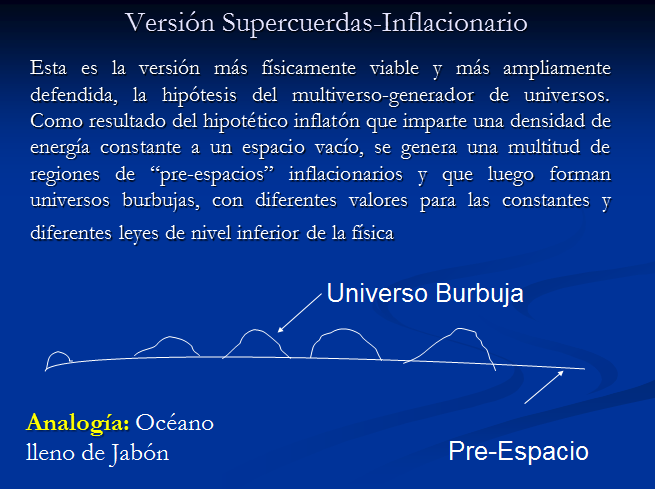
So you pick the ocean of your choice, then pour a lot of soap on it, so thousands of bubbles are formed, and these are the universes, of course, the ocean keeps expanding at a great rate so the bubbles never collide with each other.
We now turn to the answer that Robin Collins focuses on to rule out the Universe Generator hypothesis, which is this: The Universe Generator itself would have to be “well designed” to produce a single universe that would support life.
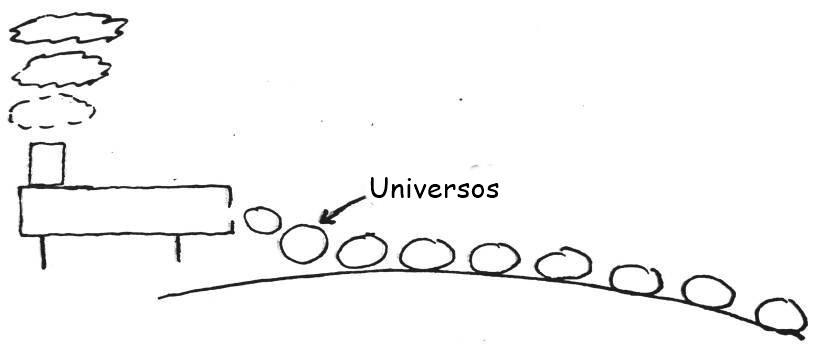
Professor Collins gives us the following analogy of the Universe Generator:
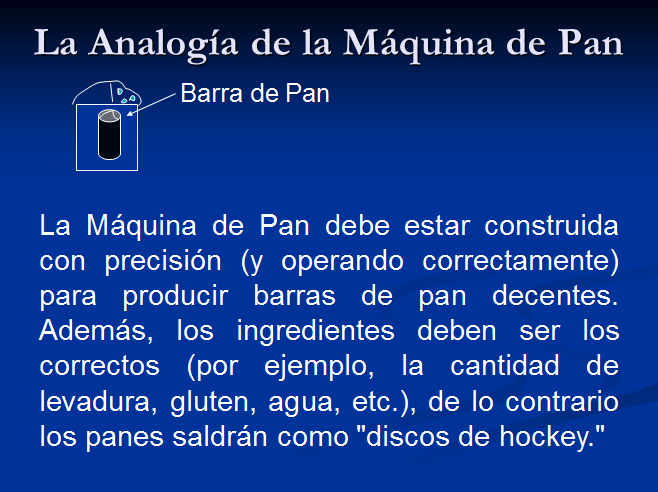
Much like the bread machine, it seems that the Universe Generator must have the right laws and have the right ingredients (initial conditions) to produce universes that support life.
Professor Collins tells us that if we examine the super-string inflationary multiverse carefully, it requires at least five special mechanisms/laws in order to produce at least one life-supporting universe. So he simply sends the design issue up one level. Collins concludes that at best, the Universe Generator hypothesis eliminates the quantitative case for design based on fine-tuning of constants, but it still requires precise laws and the right initial conditions in order to work. So after all, we can still ask the valid question: “Who or what ‘designed’ the Universe Generator?”
Design Hypothesis
Since we have ruled out physical necessity and chance from our basket of alternatives, we can now state the second premise of our argument:
- The fine-tuning of the universe is due neither to physical necessity nor to chance.
But if that is the case, then it inevitably follows that
- Therefore, the fine-tuning of the universe is due to design.
One would think that the “design” alternative is just an option offered by theists on a whim or because they simply “need to fill the gap” left by science, so it must necessarily be included in the list of explanations and not as a common sense interpretation. But that is not so, that fine-tuning is due to design is not only a claim made by theistic cosmologists, but by non-theists as well! Theoretical physicist and popular science writer Paul Davies states: “The impression of design is overwhelming” [8] and astrophysicist Sir Fred Hoyle, who was an atheist, once stated: “A common sense interpretation of the facts suggests that a super-intellect has tinkered with physics… and that there are no blind forces of nature . ”
Robin Collins’ Fine-Tuning Argument
The main feature of this argument is that it does not say that the evidence for fine-tuning proves that the universe was designed, or even that the universe is likely to have been designed. Rather, the argument simply concludes that fine-tuning strongly supports theism over the atheistic one-universe hypothesis.
Our first premise of the argument can be stated as follows:
- The existence of fine-tuning is not improbable under theism.
As we have seen throughout the article, justifying this premise is easy and not at all controversial: since God is a good being and it is good that intelligent and conscious beings exist, it is neither surprising nor unlikely that God would create a world that can sustain intelligent life.
The following premise may be as follows:
- The existence of fine-tuning is highly unlikely under the atheistic single-universe hypothesis.
This premise encompasses the options presented in an atheistic worldview: chance/brute fact and physical necessity. The objections are the same as those we used above for Craig’s argument.
And the conclusion of the argument would be:
- From premises (1) and (2) and by inference from the overriding confirmation principle, it follows that the fine-tuning data provide strong evidence in favor of the design hypothesis over the atheistic single-universe hypothesis.
This is the way Collins presents his argument. The evidence for fine-tuning is a lot like fingerprints found on a gun: although they may provide strong evidence that the defendant committed the murder, one cannot, from the evidence, conclude that the defendant is guilty; one would also have to look at the counter-evidence offered. For example, ten reliable witnesses claimed to have seen the defendant in the park at the time of the shooting. In this case, the fingerprints would still count as significant evidence of guilt, but this evidence would be counterbalanced by the testimony of the witnesses. Similarly, the evidence for fine-tuning strongly supports theism over the atheistic one-universe hypothesis, although it does not by itself show that everything that is considered theism is the most plausible explanation of the world. Nevertheless, as we have seen so far, the evidence for fine-tuning provides a much stronger and more objective argument for theism than the strongest atheistic argument against theism.
Peter Williams’ Fine-Tuning Argument
The first premise of Williams’ argument [9] is as follows:
- If something exhibits specified complexity, then it is probably the product of design.
This premise appeals to our common sense of inferring design when we see a “highly improbable” event with a “very special” pattern. This is not a religious claim or a bias coming from the theist; as we have seen above, the design inference for cosmic fine-tuning arises naturally even among atheist physicists.
Our second premise is as follows:
- The fine-tuning of the universe exhibits specified complexity.
It is obvious that nothing more needs to be said to justify this premise than what has been presented for the previous arguments. It can therefore be concluded that:
- Therefore, the fine-tuning of the universe is probably the product of design.
GENERAL CONCLUSION
So at the end of the day we have a very strong case for the fine-tuning of the universe, and in turn at least three ways to make an argument for the existence of God.
I would like to end this article with a few words from King David:
The heavens declare the glory of God. The skies proclaim the work of his hands. Day by day he tells the world, night by night he makes it known. (Psalm 19:2)
Grades
[1] Translating the huge quantities from English to Spanish is complicated because it is also necessary to convert from the English system of measurement to the international one. For the conversion of the measurements my friend Chris A. Du-Pond helped me with this.
[2] Hawking, 1988, A Brief History of Time , p. 125.
[3] From the BBC special, “The Anthropic Principle.”
[4] Roger Penrose, The Emperor’s New Mind , p. 310
[5] SW Hawking, “Cosmology from the Top Down” a paper presented at the Cosmic Inflation Conference at Davis, University of California, Davis, May 29, 2003.
[6] Stephen C. Meyer, ‘Teleological Evolution: The Difference it Doesn’t Make’, www.arn.org/docs/meyer/sm_teleologicalevolution.htm
[7] Peter S. Williams, “Five Arguments For Theism,” http://www.peterswilliams.com/2016/02/09/five-arguments-for-theism/#_edn8
[8] Paul Davies, The Cosmic Code, 1988, p. 203
[9] http://www.peterswilliams.com/2016/02/09/five-arguments-for-theism/ (Last visited October 17, 2018).
Jairo Izquierdo Hernandez is the founder of Christian Philosopher . He currently works as Social Media Director and author for the Christian organization Cross Examined . He is a member of the Christian Apologetics Alliance and a worship minister at the Christian Baptist Church Christ is the Answer in Puebla, Mexico.

